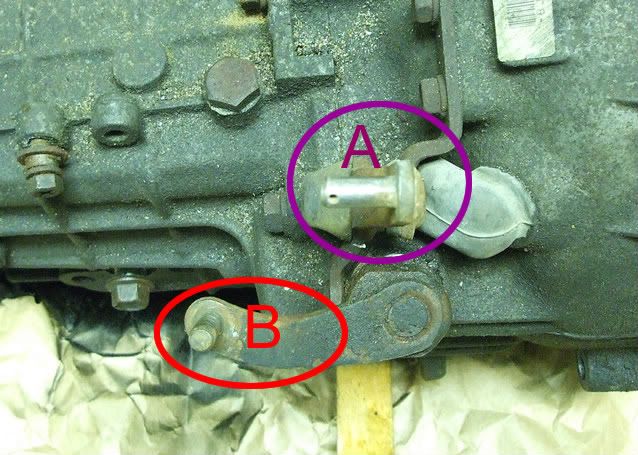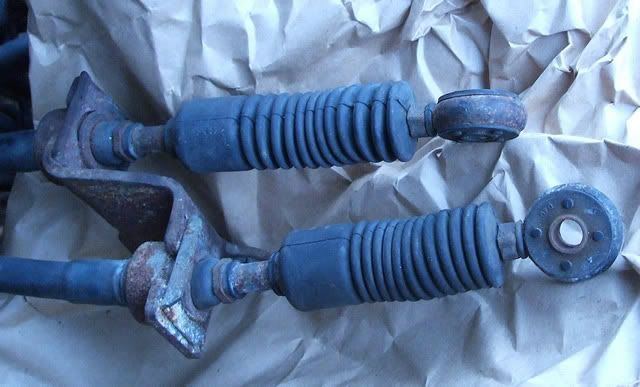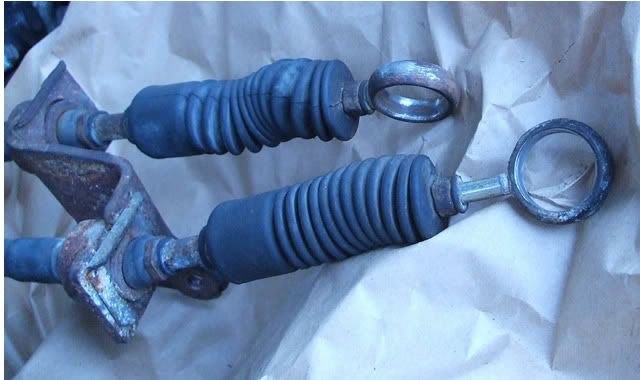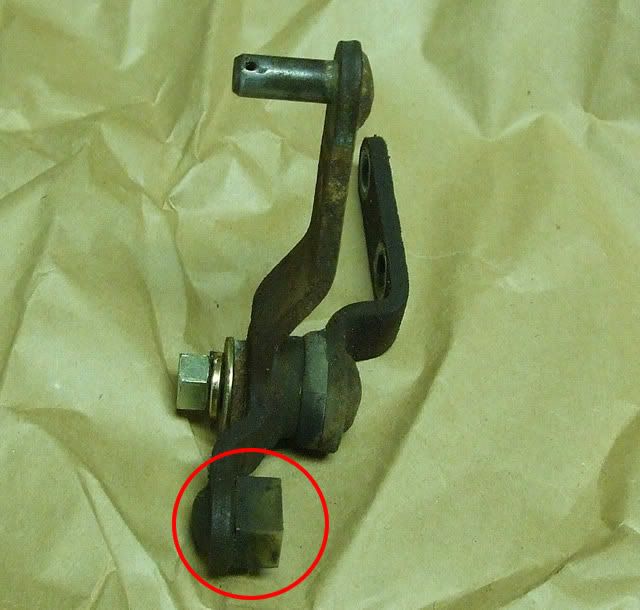RTM Racing Underhood Shifter Bushing Kit (RTM-9180)
Installation Instructions
Manual transmission equipped DSMs have two shifter cables to control shifting. One controls a shifter arm that is oriented vertically upward (arm “A” in photo 1.1 below) and another points horizontally toward the passenger side inner fender (arm “B” in photo 1.1 below). These shifter arms are located on the top of the transmission in the area underneath the thermostat housing.

Photo 1.1
Removing the Stock Bushings from the Cable Ends:
In order to safeguard against inadvertently attaching a cable to the wrong shifter arm, we recommend removing and installing one bushing at a time.
- Remove or push aside any engine components that prevent access to the cable ends.
- Remove the cotter pin that retains the cable end to the shifter arm.
- Remove the washer (if equipped) that sits atop the shifter bushing.
- Slide the shifter cable (with the bushing still attached) off the pin. If the cable end won’t readily come off, use a screwdriver to pry slightly between the arm and cable end.
- Remove the lower washer from the pin.
- Use the included emery cloth to clean the pin and arm of any rust or gunk that would prevent the new bushing from sliding freely on the pin.
- Remove the old rubber bushing from the cable end by pushing on one side of the rubber with a screwdriver. On stubborn bushings, a few firm taps with a hammer on the screwdriver may be required.
- Use the emery cloth once again to clean up the inner surface of the cable end.
Photo 2.1 below shows the cable ends with the original rubber bushings and photo 2.2 with these bushings removed.

Photo 2.1

Photo 2.2
Installing the New Bushings:
- We recommend a thin coating of grease be applied to the pin and inner surface of the cable end.
- The new bushings should be inserted into the cable end such that the narrower end of the bushing (the end with the snap ring groove) faces AWAY from the shifter arm (and the wider end rests against the shifter arm).
- Slide the new brass bushing into the cable end. The bushing should slide on with little resistance. If much resistance is encountered, confirm that the cable end is free of corrosion or foreign matter. If necessary, clean up with the emery cloth.
- Install the supplied snap ring into the groove at the top of the bushing. If the groove does not protrude above the cable end, confirm that the bushing is fully pushed in and that no foreign matter is in interfering.
- Install the cable with the new bushing onto the shifter arm pin (making sure that you’ve removed any washers that may have been there--the new shifter bushings require no washers). Remember that the side of the cable end with the snap ring should face away from the shifter arm.
- Install one of the supplied cotter pins into the hole at the end of the arm pin and you’re done!
Repeat the above procedure for the other bushing.
NOTE: there is a small, plastic square-shaped slider attached to the upward pointing shifter arm (the one labeled “A” in photo 1.1) that fits into a groove in the horizontal arm (arm “B” in photo 1.1) and provides the mechanism for actuating this arm. This square, plastic slider is known to get worn over time resulting in some sloppiness in shifting. Take a look at this slider and if it appears worn, you can correct this sloppiness by rotating the slider 90 degrees and then filing the width down a bit (if required) to fit within the groove of arm “B”. You will have to remove arm “A” from the tranny to access this slider. This is easily done—it’s attached at one end to the tranny housing with two bolts.

Photo 4.1

Photo 4.2
Photo 4.1 shows the little square slider block on arm “A” and photo 4.2 shows the corresponding grove it fits into in arm “B”.
We recommend operating the shifter in the vehicle to ensure that it operates correctly.
Re-install any engine components that were removed in the procedure.
Get out and enjoy your new shifting mechanism!
RTM Racing Underhood Shifter Bushing Kit (RTM-9180)

Categories
- New at RTM Racing
-
MITSUBISHI / EAGLE
- Eclipse / Talon / Laser
-
DSM: 1g (1990-94)
- Maintenance
- OEM Hardware
- Body & Exterior
-
Brakes
- Brake Upgrades
- Calipers
- Lines
- Rotors
- Pads
- Master Cylinder, Brake Booster, Proportioning Valve
- Parking Brake Cables, Hardware, etc
- Cooling
- Drivetrain & Transmission
- Engine
- Engine Management
- Exhaust
- Fuel
- Gauges
- Ignition & Electrical
- Intake
- Intercooler
- Interior
- Meth/Water Injection
- Suspension & Steering
- Turbo
- Wheels
- Safety
- Special Tools
-
DSM: 2g (1995-99)
- Maintenance
- OEM Hardware
- Body & Exterior
-
Brakes
-
Brake Upgrades
- 3000GT-VR4/Cobra Front Big Brake Upgrade
- 3000GT-VR4/Genesis Front Big Brake Upgrade
- Wilwood Front Big Brake Upgrade
- EVO 5-9 (Brembo) Front Big Brake Upgrade
- CTS-V (Brembo) Front Big Brake Upgrade
- Ford Cobra Front Big Brake Upgrade
- Outlander Front Big Brake Upgrade
- EVO 5-9 (Brembo) Rear Big Brake Upgrade
- Calipers
- Lines
- Rotors
- Pads/Shoes
- Master Cylinder, Brake Booster, Proportioning Valve
- Parking Brake Cables, Hardware, etc
- Brake Fluids
-
Brake Upgrades
- Cooling
- Drivetrain & Transmission
- Engine
- Engine Management
- Exhaust
- Fuel
- Gauges
- Ignition & Electrical
- Intake
- Intercooler
- Interior
- Meth/Water Injection
- Suspension & Steering
- Turbo
- Wheels
- Safety
- Special Tools
- Penetrants, Anit-Seize, Rust Removal
- DSM: 2gNT (1995-99)
-
EVO: I-III (1992-96)
- Maintenance
- OEM Hardware
- Body / Exterior
- Brakes
- Cooling
- Drivetrain & Transmission
- Engine
- Engine Management
- Exhaust
- Fuel
- Gauges
- Ignition & Electrical
- Intake
- Intercooler
- Interior
- Meth/Water Injection
- Suspension & Steering
- Turbo
- Wheels
- Safety
- Special Tools
- Penetrants, Anit-Seize, Rust Removal
-
EVO: IV-VI (1996-01)
- Maintenance
- OEM Hardware
- Body / Exterior
- Brakes
- Cooling
- Drivetrain & Transmission
- Engine
- Engine Management
- Exhaust
- Fuel
- Gauges
- Ignition & Electrical
- Intake
- Intercooler
- Interior
- Meth/Water Injection
- Suspension & Steering
- Turbo
- Wheels
- Safety
- Special Tools
- Penetrants, Anit-Seize, Rust Removal
-
EVO: VII-IX (2001-07)
- Maintenance
- Body / Exterior
- Brakes
- Cooling
- Drivetrain & Transmission
- Engine
- Engine Management
- Exhaust
- Fuel
- Gauges
- Ignition & Electrical
- Intake
- Intercooler
- Interior
- Meth/Water Injection
- Suspension & Steering
- Turbo
- Wheels
- Safety
- Special Tools
- Penetrants, Anit-Seize, Rust Removal
-
EVO: X (2008-15)
- Maintenance
- OEM Hardware
- Body & Exterior
- Brakes
- Cooling
- Drivetrain & Transmission
- Engine
- Engine Management
- Exhaust
- Fuel
- Gauges
- Ignition & Electrical
- Intake
- Intercooler
- Interior
- Meth/Water Injection
- Suspension & Steering
- Turbo
- Wheels
- Safety
- Special Tools
- Penetrants, Anit-Seize, Rust Removal
- Galant VR4 (1988-97)
- 3000GT (1991-99)
- Lancer / Ralliart
- OEM Hardware
-
Universal
- Air Filters
- Anti-Seize
- Banjo Bolts & Fittings
- Batteries & Battery Boxes
- Blowoff Valves
- Body Accessories
- Boost Controllers
- Brake Accessories
- Catch Cans
- Couplers
- CV Boot Clamps
- Engine Bay Grounding Kits
- Engine Management
- Exhaust
- Fire Extinguishers
- Fluids
- Fuel
- Fuses
- Gauges
- Heat Shields, Wraps, Coatings
- Hood Pins & Latches
- Hose
- Hose Clamps
- Hose Ends & Fittings
- Intercooler
- Interior Accessories
- Magnetic Oil Drain Plugs
- Meth/Water Injection
- Oil & Transmission Coolers
- Penetrants
- Plumbing
- Racing Seats
- Rad Fans, Rad Caps, Accessories
- Rust Removal
- Scan Tools (OBDII)
- Shift Knobs
- Silicone Couplers
- Surge Tanks
- T-Bolt Clamps
- Throttle Bodies
- Turbo
- Turbo Timers
- V-Band Clamps
- Vacuum Hose
- Wastegates
- Weld Bungs
- Wheel Accessories
- Wideband O2
- Window Stickers
- Windshield Wipers
- Y-Blocks
- Hard-to-Find Parts
- Bargain Bin
- Made by RTM
- Search don't Surf

Cart is empty

Manufacturers
Users online:
441
anonymous customer(s)
,
1
registered customer(s)
Powered by X-Cart shopping cart software
Copyright © 2003-2024 RTM Racing
